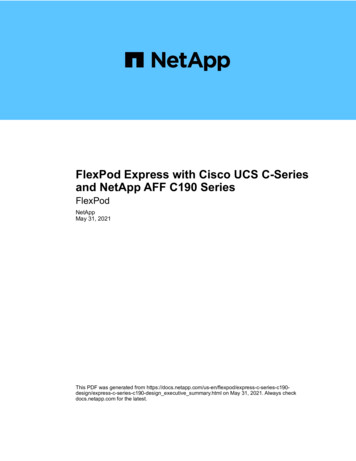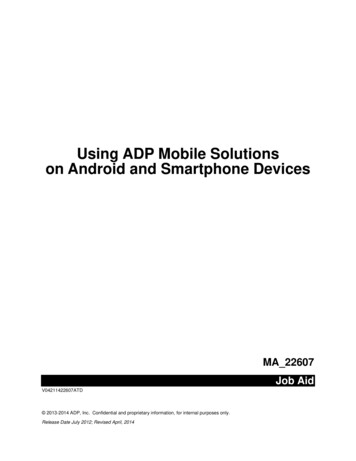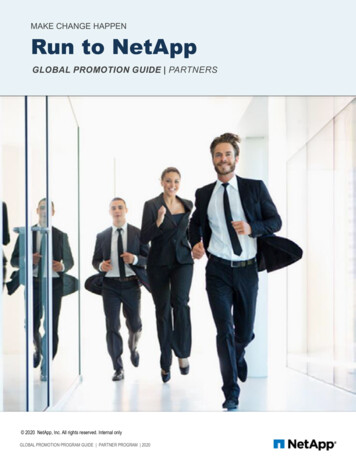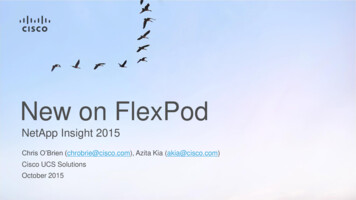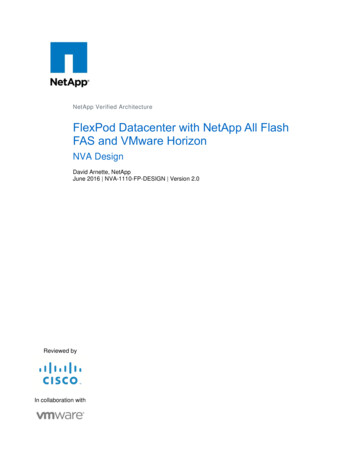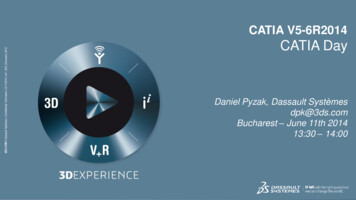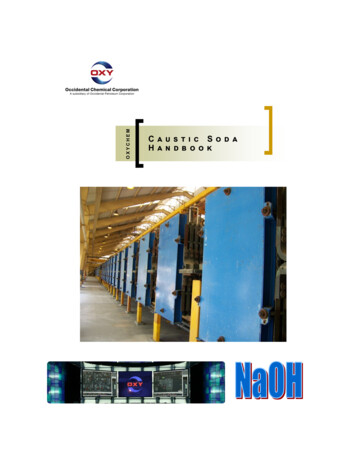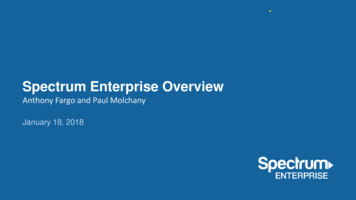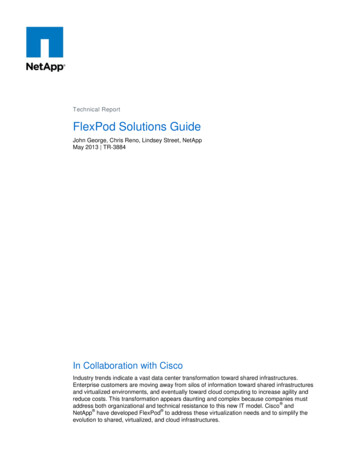
Transcription
Technical ReportFlexPod Solutions GuideJohn George, Chris Reno, Lindsey Street, NetAppMay 2013 TR-3884In Collaboration with CiscoIndustry trends indicate a vast data center transformation toward shared infrastructures.Enterprise customers are moving away from silos of information toward shared infrastructuresand virtualized environments, and eventually toward cloud computing to increase agility andreduce costs. This transformation appears daunting and complex because companies must address both organizational and technical resistance to this new IT model. Cisco and NetApp have developed FlexPod to address these virtualization needs and to simplify theevolution to shared, virtualized, and cloud infrastructures.
TABLE OF CONTENTS12345Introduction . 31.1FlexPod Design.31.2Target Audience.5Business Benefits. 52.1Repeatable.52.2Flexible.52.3Right-Sized and Scalable .52.4Lower Total Cost of Ownership .6FlexPod Design Elements . 63.1Cisco Unified Computing System .63.2Cisco Nexus 5000 and 7000 Series Switches.93.3NetApp Storage Infrastructure .103.4Management .13Data Center Solutions . 144.1FlexPod Infrastructure .144.2FlexPod Application Solutions.204.3FlexPod Data Center Integration .23Conclusion . 27References . 27LIST OF FIGURESFigure 1) FlexPod components. .4Figure 2) Example of scaling a FlexPod configuration. .5Figure 3) VASA provider collects and delivers data to vCenter Server. .14Figure 4) FlexPod solutions and applications. .15Figure 5) Base FCoE FlexPod infrastructure. .16Figure 6) iSCSI boot FlexPod infrastructure. .17Figure 7) Secure separation architecture overview. .19Figure 8) SMT architectural components.24Figure 9) VMware SRM with NetApp storage. .272FlexPod Solutions Guide
1 IntroductionIndustry trends indicate a vast data center transformation toward shared infrastructures. Enterprisecustomers are moving away from silos of information toward shared infrastructures and virtualizedenvironments and eventually toward cloud computing to increase agility and reduce costs. Thistransformation appears daunting and complex because companies must address both organizational andtechnical resistance to this new IT model. Cisco and NetApp have developed FlexPod to address thesevirtualization needs and to simplify the evolution to shared, virtualized, and cloud infrastructures. FlexPod is a predesigned base configuration that is built on the Cisco Unified Computing System (Cisco UCS ), Cisco Nexus data center switches, NetApp FAS storage components, and software from a rangeof partners. FlexPod can scale up for greater performance and capacity, or it can scale out forenvironments that need consistent, multiple deployments. FlexPod is a baseline configuration, but it alsohas the flexibility to be sized and optimized to accommodate many different business solutions. Thisdocument describes how to build several different solutions on top of FlexPod.Cisco and NetApp have developed FlexPod as a platform that can address current data center needs andsimplify the evolution toward an IT-as-a-service (ITaaS) infrastructure.FlexPod serves as a base infrastructure layer for a variety of IT solutions. A number of solutions built onFlexPod can be found at www.netapp.com/us/technology/flexpod.Authorized partners can access the FlexPod Implementation Guide, located at the NetApp Field Portal.1.1FlexPod DesignCisco and NetApp have provided documentation for best practices and the deployment collateralnecessary to build the FlexPod shared infrastructure stack. As part of the FlexPod offering, Cisco andNetApp have designed a reference architecture with a technical specifications sheet that is highlymodular, or podlike. Although each customer’s FlexPod unit can vary in its exact configuration to meettheir initial use case, once a FlexPod unit is built, it can easily be scaled as requirements and demandchange. This includes scaling both up (adding additional resources within a FlexPod unit) and out (addingFlexPod units).Specifically, FlexPod is a defined set of hardware and software that serves as a foundation for datacenter deployments. FlexPod includes NetApp storage, Cisco networking, and the Cisco UCS in a singlepackage. The solution can be scaled, while still maintaining its integrity, by augmenting a single FlexPodinstance to provide the appropriate network, compute, or storage capacity needed within a single pod orby using the port density of the Cisco Nexus 5000 networking platform to readily accommodate multipleinstances of FlexPod. In either case, the flexibility of the pod construct allows numerous solutions to bebuilt on top of one or more FlexPod configurations, providing enterprise flexibility, supportability, andmanageability for both virtualized and nonvirtualized environments. Figure 1 shows a base FlexPodconfiguration with hardware families and solution benefits.3FlexPod Solutions Guide
Figure 1) FlexPod components.FlexPodThe base hardware, which is detailed in the FlexPod technicalspecifications, includes: Two Cisco Nexus switches Two Cisco UCS 6248UP fabric interconnects Cisco UCS B-Series blades with two fabric extenders perchassis, and/or Cisco UCS C-Series rack servers (C-Seriesservers also required the Cisco Nexus 2232PP FabricExtenders) NetApp FAS3250 (highly available configuration with dualcontrollers and dual enclosures)Storage is provided by a NetApp FAS3250 with accompanying diskshelves. All systems and fabric links feature redundancy, providingend-to-end HA. Although this is the default base design, each of thecomponents can be scaled flexibly to support the customer’sspecific business requirements. For example, more (or different)blades and chassis can be deployed to increase compute capacity,additional disk shelves can be deployed to improve I/O capacity andthroughput, or special hardware or software features can be added to introduce new features, such as NetApp Flash Cache fordeduplication-aware caching.Note:If your FlexPod includes clustered Data ONTAP, you will also need a pair of cluster interconnects.FlexPod can scale up for greater performance and capacity, or it can scale out for environments thatneed consistent, multiple deployments. Figure 2 shows a few FlexPod scaling options. FlexPod is abaseline configuration, but it also has the flexibility to be sized and optimized to accommodate manydifferent use cases.4FlexPod Solutions Guide
Figure 2) Example of scaling a FlexPod configuration.FlexPod1.2Target AudienceThis document describes the basic architecture of FlexPod as well as several solutions that can be builton FlexPod. The target audience for this document includes, but is not limited to, sales engineers, fieldconsultants, professional services, IT managers, partner engineering, and customers who want to deploysolutions on top of a FlexPod configuration.2 Business BenefitsFlexPod solutions offer a variety of business benefits to the consumer. This section describes some ofthese benefits at a high level.2.1RepeatableThe FlexPod architecture and accompanying collateral, delivered by Cisco and NetApp, aid customers,partners, and field personnel with new FlexPod deployments. This configuration provides documentationabout sample workloads, required port count, power consumption, and required cooling. For customerswho want standard scalable configurations, FlexPod is an excellent choice for their infrastructuresbecause environmental requirements are defined.2.2FlexibleOne of the founding principles of the FlexPod program is flexibility. The reference architecture serves as astarting point for a variety of workloads but is not mandated as the only way to bundle the FlexPodproducts. Customers can modify server type and count, storage type and scale, and network switches, forexample, based on their specific needs.2.3Right-Sized and ScalableThe reference architecture is outlined in detail in TR-3151: FlexPod Data Center Solutions Sizing Guide,which is a starting point for building and sizing shared infrastructure solutions.5FlexPod Solutions Guide
The sizing of the reference architecture is based on a design principle of supporting concurrent workloadson a right-sized platform. The FlexPod architecture is designed to concurrently support various applications and use cases such as VMware View , Microsoft Exchange Server 2010, Microsoft SharePoint 2010, SAP , and many others.Depending on their application requirements, customers can choose the appropriate hardware for theirdeployments. This allows them to avoid purchasing an infrastructure stack that is underused.Note:2.4The sizing data covers typical enterprise workloads; however, individual customers might havelighter or heavier workloads related to the greater headroom required for growth or during systemfailure. Take these factors into consideration when sizing for individual customers.Lower Total Cost of OwnershipBecause the FlexPod architecture is repeatable, flexible, and right-sized to application requirements, thepurchase cost, deployment time, and provisioning time are all lowered. This standardized approach to thedata center also decreases training time for staff and increases their ability to work with tenants' ordifferent business units' equipment. These are substantial benefits to the customer, and when combinedwith NetApp storage efficiency and Cisco UCS stateless computing, they can lower the total cost ofownership (TCO) of the infrastructure.3 FlexPod Design ElementsThis section describes the elements that compose a FlexPod architecture. Because FlexPod is not a rigidconfiguration, the customer can build an infrastructure that includes best-in-class technologies from Ciscoand NetApp.3.1Cisco Unified Computing SystemThe Cisco UCS is a next-generation data center platform that unites compute, network, storage access,and virtualization into a cohesive system designed to reduce TCO and increase business agility. Thesystem integrates a low-latency, lossless 10 Gigabit Ethernet (10GbE) unified network fabric withenterprise-class, x86-architecture servers. The system is an integrated, scalable, multichassis platform inwhich all resources participate in a unified management domain. A Cisco UCS deployment consists ofCisco UCS Fabric Interconnects, blade server chassis, B-Series blades, C-Series rack mount servers(with required Cisco Nexus 2232PP Fabric Extenders), and adapter connectivity.For more information, refer to the following documentation: Cisco UCS white papers:www.cisco.com/en/US/netsol/ns944/networking solutions white papers list.html Unified Computing and .htmlCisco UCS ManagerCisco UCS Manager (Cisco UCSM) is robust device management software that is embedded in everyCisco UCS deployment and can support up to 160 servers. Cisco UCSM allows management of theentire compute environment from a highly available single pane of glass. Cisco UCS Manager providesflexible role-based and policy-based management of resources through the use of service profiles andtemplates. The use of service profiles and templates abstracts those elements that typically denote serverpersonality (such as MAC address, WWPN, system UUID, and firmware revisions) from the role that thecompute resource serves in the data center. Through this methodology, firmware, boot order, NIC andHBA settings, boot targets, and so on are no longer tied to a specific piece of server hardware. Thisapproach enables IT infrastructure to be deployed in minutes rather than days and allows organizations tofocus on strategy rather than on monotonous maintenance tasks.6FlexPod Solutions Guide
With respect to element management, Cisco UCS Manager provides: Device discovery Firmware management Inventory Kernel-based virtual machine (VM) console access Diagnostics Quality of service (QoS) Monitoring Statistics collection AuditingCisco UCS Fabric InterconnectThe Cisco UCS 6100 or 6200 Series Fabric Interconnects is a core part of the Cisco UCS, providing bothnetwork connectivity and management capabilities for the system as this device is where Cisco UCSMresides. Deployed as a clustered pair, the Cisco UCS 6100 or 6200 Series Fabric Interconnects offer linerate, low-latency, lossless 10GbE and Fibre Channel over Ethernet (FCoE) functions.The Cisco UCS 6100/6200 Series Fabric Interconnects are the management and communicationbackbone for the Cisco UCS B-Series Blade Servers, the Cisco UCS 5100 Series Blade Server Chassis,and C-Series Rack-Mount Servers (connected through Nexus 2232PP Fabric Extenders). All chassis, allblades, and all rack-mounts attached to the Cisco UCS 6100/6200 Series Fabric Interconnects becomepart of a single highly available management domain. In addition, by supporting unified fabric, the CiscoUCS 6100/6200 Series Fabric Interconnects provide both the LAN and the storage area network (SAN)connectivity for all blades within its domain.Note:The Cisco UCS 6200UP supports unified ports; therefore, ports can be configured to support10GbE, Fibre Channel (FC), or FCoE.Cisco UCS B-Series Blades and Blade Server ChassisThe Cisco UCS 5100 Series Blade Server Chassis is a crucial building block of the Cisco UCS, deliveringa scalable and flexible blade server chassis for today’s and tomorrow’s data center while helping toreduce TCO.Cisco’s first blade server chassis offering, the Cisco UCS 5108 Blade Server Chassis, is six rack unitshigh and can be mounted in an industry-standard 19-inch rack. A chassis can house up to eight half-widthCisco UCS B-Series Blade Servers and can accommodate both half-width and full-width blade formfactors. There are currently six blade server options for sale from which to choose: Cisco UCS B22 M3 blade server Cisco UCS B200 M3 blade server Cisco UCS B250 M2 Extended Memory blade server Cisco UCS B230 M2 blade server Cisco UCS B420 M3 blade server Cisco UCS B440 M2 High Performance blade serverFour single-phase, hot-swappable power supplies are accessible from the front of the chassis. Thesepower supplies are 92% efficient and can be configured to support nonredundant, N 1-redundant, andgrid-redundant configurations. The rear of the chassis contains eight hot-swappable fans, four powerconnectors (one per power supply), and two input/output (I/O) bays for either the Cisco UCS 2104XP or2208XP Fabric Extenders.7FlexPod Solutions Guide
A passive midplane provides up to 20Gbps of I/O bandwidth per half-width server slot and up to 40Gbpsof I/O bandwidth per full-width server slot. The chassis is capable of supporting future 40GbE standards.Cisco UCS C-Series Rack-Mount ServersCisco UCS C-Series Rack-Mount Servers extend unified computing innovations to an industry-standardform factor to help reduce TCO and increase business agility. The innovations embodied in this seriesinclude a standards-based unified network fabric, Cisco VN-Link virtualization support, and CiscoExtended Memory Technology. It supports an incremental deployment model and protects customerinvestment with a migration path to unified computing.There are currently seven rack mount server options for sale from which to choose: Cisco UCS C22 M3 rack server Cisco UCS C220 M3 rack server Cisco UCS C24 M3 rack server Cisco UCS C240 M3 rack server Cisco UCS C260 M2 rack server Cisco UCS C420 M3 rack server Cisco UCS C460 M2 rack serverEach server model addresses varying workload challenges through a balance of processing, memory,I/O, and internal storage resources.For more information, refer to the following documentation: Cisco UCS C-Series Rack-Mount Servers: co UCS Virtual Interface CardCisco virtual interface cards (VICs) were developed from the ground up to provide acceleration for thevarious new operational modes introduced by server virtualization. The VICs are highly configurable, selfvirtualized adapters that can create up to 128 PCI Express (PCIe) endpoints per adapter. These PCIeendpoints are created in the adapter firmware and present fully compliant standard PCIe topology to thehost OS or hypervisor. Versions of the VIC are available for both the B-Series blades and the C-Seriesrack-mount servers.Each of the PCIe endpoints created by the VIC can be configured individually for the following attributes: Interface type. FCoE, Ethernet, or Dynamic Ethernet interface device Resource maps that are presented to the host. PCIe base address registers, interrupt arrays Network presence and attributes. Maximum transmission unit, VLAN membership Quality of service parameters. 802.1p class, enhanced transmission selection (ETS) attributes, ratelimiting, and shaping8FlexPod Solutions Guide
3.2Cisco Nexus 5000 and 7000 Series SwitchesThe networking foundation for any FlexPod deployment is the Cisco Nexus family of switches. The CiscoNexus 5000 and 7000 Series enable any transport over Ethernet, including Layer 2 and Layer 3 trafficand storage traffic, on one common data center-class platform. Cisco Nexus 5000 and 7000 SeriesSwitches help transform your data center with a standards-based, multipurpose, multiprotocol, Ethernetbased fabric. All switches in the Cisco Nexus family of switches leverage the NX-OS operating system.Cisco Nexus 5000 Series SwitchesCisco Nexus 5000 Series switches are ideal for enterprise-class data center server access layer andsmaller-scale, midmarket data center aggregation layer deployments. These multipurpose, multilayerswitches can be deployed across a diverse set of traditional, virtualized, unified, and high-performancecomputing (HPC) environments.As part of the foundation for FlexPod, these switches help address business, application, and operationalrequirements of evolving data centers. They provide: Architectural flexibility to support diverse business and application needs Infrastructure simplicity to decrease TCO Agility for traditional deployments, with easy migration to virtualized, unified, or HPC environments Enhanced business resilience with greater operational continuity based on the modular Cisco NX-OSoperating system Ability to use existing operational models and administrative domains for easy deployment Nonblocking, resilient architecture based on Virtual PortChannel (vPC), which removes thedependency on spanning treeThe Cisco Nexus 5000 Series also expands Cisco Fabric Extension technology into the servers and VMswith Cisco Adapter FEX and Cisco VM-FEX.The switch family’s rich feature set makes the series ideal for rack-level, access-layer applications. Itprotects investments in data center racks with standards-based Ethernet and FCoE features that allow ITdepartments to consolidate networks based on their own requirements and timing.The combination of high port density, wire-speed performance, and extremely low latency makes theswitch an ideal product to meet the growing demand for 10GbE at the rack level. The switch family hassufficient port density to support single or multiple racks that are fully populated with blade and rackmount servers.Built for today’s data centers, the switches are designed just like the servers they support. Ports andpower connections are at the rear, closer to server ports, helping keep cable lengths as short and efficientas possible. Hot-swappable power and cooling modules can be accessed from the front panel, wherestatus lights offer an at-a-glance view of switch operation. Front-to-back cooling is consistent with serverdesigns, supporting efficient data center hot-aisle and cold-aisle designs. Serviceability is enhanced withall customer-replaceable units accessible from the front panel. The use of Small Form-Factor PluggablePlus (SFP ) ports offers increased flexibility to use a range of interconnect solutions, including copper forshort runs and fiber for long runs.FCoE and IEEE Data Center Bridging features support I/O consolidation, simplify management of multipletraffic flows, and optimize performance. Although implementing SAN consolidation requires only thelossless fabric provided by the Ethernet pause mechanism, the Cisco Nexus 5500 Series offers additionalfeatures that create an even more easily managed, high-performance, unified network fabric.For more information, refer to the following documentation: 9Cisco Nexus 5500 Series Switches: Pod Solutions Guide
Cisco Nexus 7000 Series SwitchesThe Cisco Nexus 7000 Series offers a comprehensive, one-platform solution for the data center corenetwork. It also provides aggregation, high density, and end-of-row and top-of-rack server connectivity.For campus core deployments, it offers a scalable, highly resilient, high-performance solution.The Cisco Nexus 7000 Series platform runs on Cisco NX-OS software. It was specifically designed for themost mission-critical deployments in the data center and campus.The Cisco Nexus 7000 Series was designed around three principles: Infrastructure scalability: Virtualization, efficient power and cooling, high density, and performanceall support efficient data center infrastructure growth. Operational continuity: The Cisco Nexus design integrates hardware, NX-OS software features,and management to support zero-downtime environments. Transport flexibility: You can incrementally and cost-effectively adopt new networking innovationsand technologies.New technologies that you can support include: Cisco Overlay Transport Virtualization (OTV) Cisco FabricPath Fibre Channel over Ethernet (FCoE) Cisco Locator/ID Separation Protocol (LISP)3.3NetApp Storage InfrastructureThe NetApp Unified Storage Architecture provides customers with an agile and scalable storage platform. All NetApp storage systems use the NetApp Data ONTAP operating system. Both Data ONTAP 7-Modeand clustered Data ONTAP are supported in FlexPod. Both operating systems provide SAN (FCoE, FC,iSCSI), NAS (CIFS, NFS), and primary and secondary storage in a single unified platform so that allvirtual desktop data components can be hosted on the same storage array. A single process for activitiessuch as installation, provisioning, mirroring, backup, and upgrading is used throughout the entire productline, from the entry level to enterprise-class controllers. Having a single set of software and processesbrings great simplicity to even the most complex enterprise data management challenges. Unifyingstorage and data management software and processes reduces the complexity of data ownership,enables companies to adapt to their changing business needs without interruption, and results in reducedTCO.In a shared infrastructure, the availability and performance of the storage infrastructure are criticalbecause storage outages or performance issues can affect thousands of users. The storage architecturemust provide a high level of availability and performance. For detailed documentation about bestpractices, NetApp and its technology partners have developed a number of best practice documents.For more information, refer to the following documentation: NetApp Data Storage Systems TR-3437: Storage Subsystem Resiliency Guide TR-3450: High-Availability Pair Controller Configuration Overview and Best Practices TR-3633: NetApp Best Practice Guidelines for Oracle Database 11g TR-3702: NetApp Storage Best Practices for Microsoft Virtualization and NetApp SnapManager forHyper-V TR-3705: NetApp and VMware View Solution Guide TR-3749: NetApp Storage Best Practices for VMware vSphere TR-3824: Storage Efficiency and Best Practices for Microsoft Exchange Server 201010FlexPod Solutions Guide
TR-4068: VMware vSphere 5 on NetApp Clustered Data ONTAP 8.1 NVA-0005: VMware vSphere on FlexPod. Validated with Clustered Data ONTAP and Data ONTAPOperating in 7-ModeNetApp Unified Storage ArchitectureWhen it comes to storage platforms, NetApp views simplicity as the key to delivering value to customers.That’s why every NetApp storage controller is available with the Data ONTAP operating system. DataONTAP is the foundation for providing unified storage through multiprotocol support on every platform.The NetApp family of controllers consists of platforms that are capable of serving all business needs. TheFlexPod program leverages the FAS3xxx and FAS6xxx product lines to build efficient infrastructures.RAID-DPWith any shared infrastructure deployment, data protection is critical because any RAID failure couldresult in hundreds to thousands of end users being disconnected from their virtual desktops or applications, resulting in lost productivity. NetApp RAID-DP offers performance that is comparable to thatof RAID 10, yet it requires fewer disks to achieve equivalent protection. RAID-DP protects against doubledisk failure, as compared to RAID 5, which can protect against only one disk failure per RAID group. Formore information about RAID-DP, refer to TR-3298: RAID-DP: NetApp Implementation of Double-ParityRAID for Data Protection.Storage EfficiencyOne of the critical barriers to adopting shared infrastructure is the increased cost of using shared storageto obtain a highly available enterprise-quality infrastructure. Virtual desktop and other enterprisedeployments can create a high level of data redundancy, especially for the VM OS data. With traditionalstorage, the total storage required equals the sum of the storage required by each VM. For example, ifeach VM is 20GB in size, and there are 1,000 VMs in the solution, it would require at least 20TB of usabledata on the shared storage. Thin provisioning, data deduplication, and FlexClone thin-cloning technology are the critical componentsof the NetApp solution, offering multiple levels of storage efficiency across the virtual desktop OS data,installed applications, and user data. This helps customers save 50% to 90% of the cost associated withshared storage (based on existing customer deployments and NetApp solutions lab validation).Flexible Volumes and AggregatesAggregates are the NetApp virtualization layer, which abstracts physical disks from logical datasets, referred to as flexible volumes (also known as NetApp FlexVol volumes). Aggregates offer storageadministrators pooled disk resources, including input/output operations per second (IOPS). The FlexVolvolumes contained in each aggregate have their own unique logical capacity. FlexVol volumes can bethin provisioned and the logical capacity resized as needed by the storage administrator.FlexVol volumes are shared out as file-level (NFS or CIFS) mount points or are further allocated as LUNs for block-level (iSCSI or FCP) access. FlexVol volumes can be readily offered to the VMwareenvironment
1.1 FlexPod Design Cisco and NetApp have provided documentation for best practices and the deployment collateral . FlexPod Data Center Solutions Sizing Guide, . The Cisco UCS is a next-generation data center p


